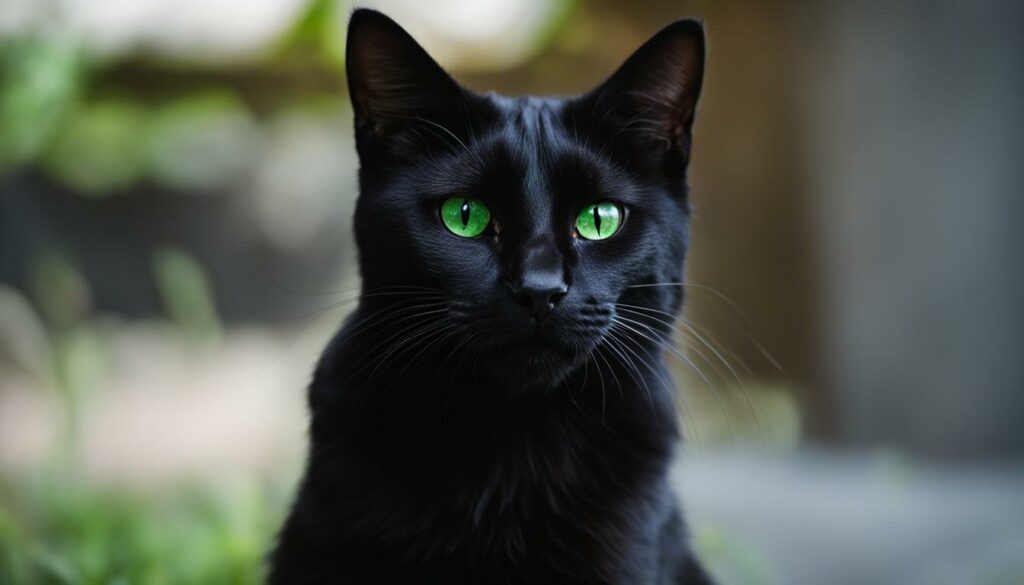Have you ever wondered why your cat meows and then quickly scurries away? This peculiar behavior can leave cat owners puzzled and longing for a deeper understanding of their feline companions. In this article, we will explore the fascinating world of cat behavior, unravel the mysteries behind why cats meow and run away, and provide insights into their unique forms of communication.
Our beloved cats communicate with us in various ways, using a combination of vocalizations, body language, and even scent marking. By deciphering the subtle cues they give us, we can better interpret their needs and emotions, ultimately strengthening our bond and improving our relationship with these enigmatic creatures.
Key Takeaways:
- Cats meow and run away for various reasons, including anxiety, fear, confusion, hunger, and even playfulness.
- Understanding cat communication, body language, and vocalization can provide valuable insights into their behavior.
- Anxiety and stress can lead to excessive meowing and running away, but techniques such as creating a calm environment and providing interactive toys can help alleviate these issues.
- Fear of the dark may cause cats to meow and run away, but providing a small source of dim lighting can ease their discomfort.
- Cats may prefer a specific person and exhibit clingy behavior, but building trust with other family members can help reduce this behavior.
Common Reasons for Cat Meowing and Running Away
Understanding why cats meow and then run away can help improve the relationship with our feline friends. There are several common reasons for this behavior that cat owners should be aware of. These reasons can include anxiety or stress, fear of the dark, a preference for a specific person, confusion or disorientation, or even hunger.
Anxiety or stress can lead to meowing and running away in cats. Changes in the environment, lack of routine, or a traumatic experience can trigger anxiety in cats. Creating a calm environment, using pheromone sprays or diffusers, and providing interactive toys can help alleviate anxiety and reduce this behavior.
Fear of the dark is another possible reason why cats may meow and then run away. Despite their excellent night vision, some cats may still feel uneasy in dark environments. Providing a night light or a small source of dim lighting can help ease their discomfort without disrupting their sleep.
A cat’s preference for a specific person can also contribute to this behavior. Cats can develop a strong attachment to a particular individual and may exhibit clingy or needy behavior towards them. Building trust and strengthening the bond with other family members can help reduce this behavior and encourage the cat to approach others without fear.
| Reasons for Cat Meowing and Running Away | Possible Solutions |
|---|---|
| Anxiety or stress | – Create a calm environment – Use pheromone sprays or diffusers – Provide interactive toys |
| Fear of the dark | – Provide a night light or dim lighting |
| A cat’s preference for a specific person | – Build trust with other family members – Strengthen the bond with the cat |
Confusion or disorientation and hunger are also common reasons for cat meowing and running away. Providing a consistent routine, a safe environment, and scheduled meals can help alleviate these behaviors. It’s important to remember that every cat is unique, and understanding their individual needs and behaviors is key to creating a harmonious living environment.
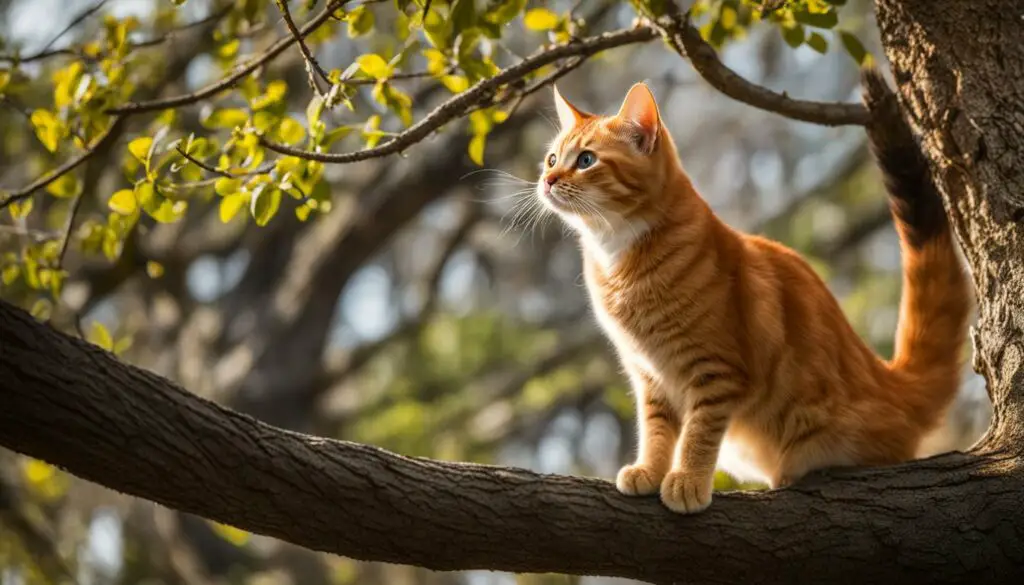
References:
- “Understanding Cat Behavior”, American Society for the Prevention of Cruelty to Animals (ASPCA)
- Why Does My Cat Run Away From Me?”, The Spruce Pets
- “Cat Anxiety: Causes, Symptoms, and Treatment”, PetMD
Anxiety and Stress in Cats
Dealing with anxiety and stress is crucial when it comes to understanding why cats meow and run away. Cats can experience anxiety due to changes in their environment, lack of routine, or even a traumatic experience. It’s important to address these issues to help alleviate their distress and improve their overall well-being.
To create a calming environment for your cat, consider using pheromone sprays or diffusers, which release synthetic pheromones that mimic the natural ones produced by cats. These products have been shown to have a soothing effect and can help reduce anxiety. Additionally, providing interactive toys and engaging in playtime can help keep your cat mentally stimulated and distracted from stressful situations.
When dealing with an anxious cat, it’s important to create a safe space where they can retreat to when they feel overwhelmed. This can be a cozy corner with a comfortable bed or a designated room where they can have some alone time. By understanding and addressing their anxiety, you can help your cat feel more secure and reduce their need to meow and run away.
| Anxiety Triggers | Methods to Alleviate Anxiety |
|---|---|
| Changes in the environment | Use pheromone sprays or diffusers |
| Lack of routine | Provide interactive toys for mental stimulation |
| Traumatic experience | Create a safe space for your cat to retreat to |
Remember: Always consult with a veterinarian to rule out any underlying health conditions that may be contributing to your cat’s anxiety. They can provide further guidance and recommend additional strategies to help manage your cat’s stress levels.
Fear of the Dark
Some cats may exhibit fear or discomfort in dark environments, leading to meowing and running away behaviors. While cats have excellent night vision, specific individuals may still experience anxieties related to darkness. To address this issue, it is helpful to provide a small source of dim lighting, such as a night light, in areas where the cat spends time. This can alleviate their fears without disrupting sleep or necessitating the use of bright lights throughout the night.
Creating a Comfortable Environment
Creating a comfortable environment is essential for cats who fear the dark. By ensuring that their surroundings are safe and familiar, you can help alleviate their anxieties. Consider providing cozy hiding spots or cat beds in well-lit areas of your home. Additionally, maintaining a regular routine can help cats feel more secure and reduce their fear or disorientation in the dark.
“It is essential to remember that cats’ fear of the dark is instinctual and can vary from individual to individual. By understanding their needs and providing a well-lit, secure environment, we can help them feel safe and comfortable.”
For cats with severe fear of the dark, it may be beneficial to consult with a veterinarian or a professional animal behaviorist. They can provide additional guidance and recommend strategies to address the issue effectively.

| Common Behaviors Associated with Fear of the Dark | Strategies to Alleviate Fear |
|---|---|
| Hiding in dark corners or under furniture | Provide well-lit areas and cozy hiding spots |
| Excessive meowing or crying in the dark | Try using a night light or dim lighting to ease their anxiety |
| Avoiding certain rooms or areas of the house at night | Ensure the cat has easy access to well-lit areas throughout the house |
Remember, each cat is unique, and their fear of the dark may stem from various factors. It’s essential to be patient and understanding as you work to alleviate their fears and provide a safe and comforting environment.
Cat’s Preference for a Specific Person
When it comes to cats, it’s not uncommon for them to develop a strong attachment to a specific person. This preference can manifest in various ways, including meowing outside their chosen person’s room while refusing to enter. Understanding this behavior and its underlying reasons is crucial in building a strong bond with your feline friend.
Building trust and strengthening the bond with other family members can help alleviate this behavior. By engaging in positive interactions, such as playtime and grooming, with other household members, you can gradually increase your cat’s comfort level with them. It’s important to remember that this process takes time and patience, as cats can be creatures of habit.
To foster a stronger bond between your cat and other family members, try involving them in activities that your cat enjoys. This can include providing treats or engaging in interactive playtime together. By associating positive experiences with different individuals, your cat may become more open to their presence and ultimately reduce the meowing and running away behavior.
Remember, every cat is unique, and it’s essential to respect their individual preferences and boundaries. By understanding and accommodating your cat’s attachment to a specific person, you can create a harmonious environment where everyone can coexist peacefully.

Table: Tips for Building a Stronger Bond with Your Cat
| Tip | Description |
|---|---|
| Provide positive reinforcement | Use treats and praise to reward desired behavior and create positive associations. |
| Create a calm environment | Offer a quiet space and minimize stressful stimuli to help your cat feel more at ease. |
| Engage in interactive play | Use toys to stimulate your cat’s mind and provide physical exercise, strengthening the bond between you. |
| Respect their boundaries | Allow your cat to approach you on their terms and avoid forcing interaction. |
“A cat’s preference for a specific person is a natural behavior that can be influenced by various factors, including past experiences and individual personalities. By understanding and respecting your cat’s attachment, you can create a loving and inclusive environment for all members of your household.” – Cat Behavior Expert
Confusion or Disorientation
Cats can sometimes become confused or disoriented, leading to behaviors like meowing and running away. This confusion could be due to age-related cognitive decline or feeling unsure of their surroundings. It’s important to provide a consistent routine and create a safe and comfortable environment for your cat to help alleviate this behavior.
Consulting with a veterinarian is also crucial, as they can identify any underlying health issues that may be contributing to your cat’s confusion. Age-related cognitive decline is common in older cats, and there may be medical interventions or dietary changes that can help support their cognitive function.
In addition to physical care, mental stimulation is essential for cats experiencing confusion or disorientation. Engaging in interactive play sessions, providing puzzle toys or treat-dispensing toys, and creating a stimulating environment with scratching posts and hiding spots can all help keep your cat’s mind active and engaged.
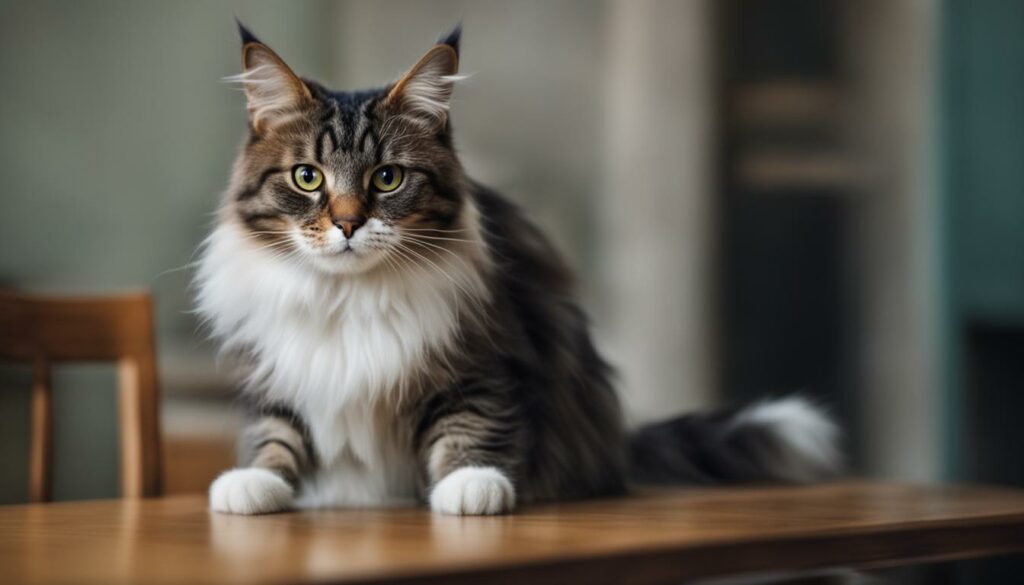
Common Signs of Confusion or Disorientation in Cats:
- Wandering aimlessly or pacing
- Getting “stuck” in corners or behind furniture
- Repetitive behaviors, such as excessive grooming or meowing
- Forgetting previously learned behaviors or routines
- Becoming startled easily or displaying increased anxiety
“Understanding and addressing your cat’s confusion or disorientation is crucial for their well-being. By providing a consistent routine, creating a stimulating environment, and seeking veterinary care, you can help your cat navigate through their moments of uncertainty and provide them with the care and support they need.”
Hunger and Meowing
Hunger is a common reason why cats may meow and then run away. While it’s important to ensure that your cat is receiving enough food and scheduled meals, some cats may still exhibit this behavior even if they have been fed. This could indicate other underlying issues such as anxiety or discomfort.
To address hunger-related meowing, it’s essential to establish a regular feeding schedule for your cat. This helps create a sense of routine and reduces the likelihood of excessive meowing. It’s recommended to consult with your veterinarian to determine the appropriate portion sizes and feeding frequency based on your cat’s age, breed, and health condition. Remember, a well-fed cat is less likely to exhibit attention-seeking behavior.
In addition to a consistent feeding schedule, you can also provide mental stimulation for your cat by using food puzzle toys or interactive feeders. These toys allow cats to work for their food, keeping them engaged and mentally stimulated. Not only does it help reduce meowing, but it also provides a fun and enriching experience for your cat.
“Feeding my cat on a regular schedule has made a significant difference in reducing her meowing. It’s like she knows exactly when mealtime is and doesn’t feel the need to meow incessantly anymore!” – Cat owner
| Meowing and Running Away | Possible Solutions |
|---|---|
| Excessive meowing due to hunger | Establish a regular feeding schedule and use interactive feeders or food puzzle toys to provide mental stimulation. |
| Meowing despite being fed | Consult with a veterinarian to ensure proper portion sizes and feeding frequency. Address any underlying issues such as anxiety or discomfort. |
By addressing hunger-related meowing and providing a consistent feeding routine, you can help reduce this behavior and create a more harmonious environment for both you and your feline companion.
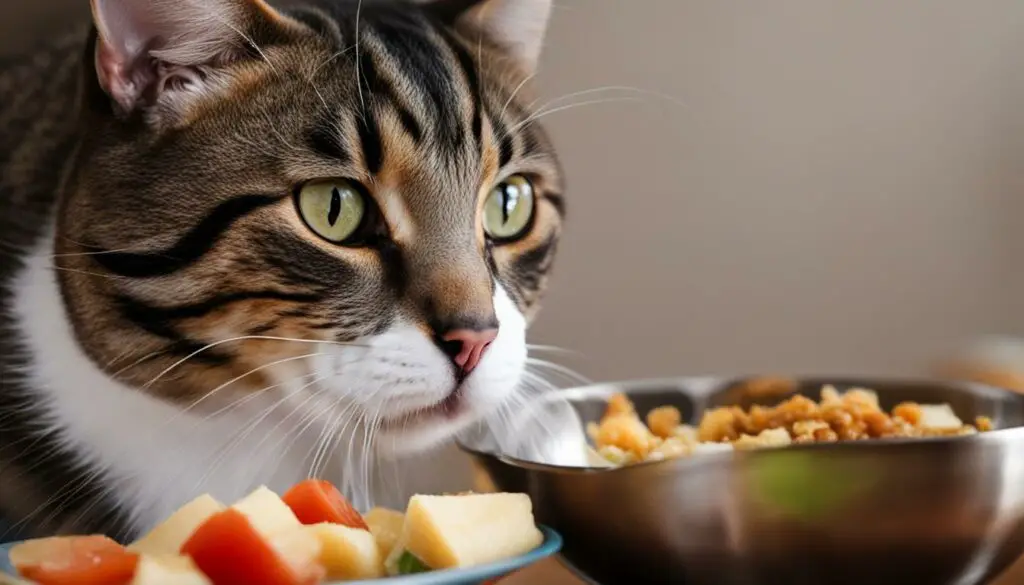
Methods to Address Meowing and Running Away Behavior
Addressing meowing and running away behavior in cats requires a proactive and positive approach. By implementing various techniques and strategies, you can effectively redirect your cat’s attention and discourage unwanted behavior. Here are some methods to consider:
Positive Reinforcement
Positive reinforcement involves rewarding desired behavior to encourage its repetition. When your cat approaches you without meowing and running away, offer treats or praise to reinforce the behavior. By associating positive experiences with calm interactions, your cat will be more likely to engage in desired behaviors.
Create a Calm Environment
A calm and stress-free environment can greatly reduce meowing and running away behavior in cats. Provide your cat with a designated safe space where they can retreat when they feel anxious or overwhelmed. This could be a cozy bed, a quiet room, or a cat tree. Additionally, ensure that your cat has access to stimulating toys and scratching posts to keep them mentally and physically engaged.
Engage in Interactive Playtime
Cats have a natural instinct to hunt and play, so incorporating interactive playtime into their daily routine can help satisfy their need for stimulation. Use toys that mimic prey, such as wand toys or laser pointers, and engage your cat in active play sessions. This not only provides mental and physical exercise but also strengthens the bond between you and your cat.
Remember, each cat is unique, and it may take time to find the most effective methods for addressing their specific meowing and running away behavior. Be patient, consistent, and observe your cat’s responses to the various techniques. With time and effort, you can help your cat feel more comfortable and secure, leading to a happier and more harmonious relationship.
Understanding Cat Communication
When it comes to understanding our feline friends, it’s essential to decode their unique language of communication. Cats, like humans, have their own ways of expressing themselves through meows, body language, and other subtle cues. By interpreting their meows and observing their body language, we can gain valuable insights into their needs, emotions, and behaviors.
Interpreting Cat Meows
Cats use meows as a form of communication to express a range of emotions and desires. Each meow may have a different meaning, and it’s crucial to pay attention to the context and tone. For example, a short, high-pitched meow could indicate excitement or anticipation, while a long, low-pitched meow might indicate frustration or dissatisfaction.
It’s also essential to consider the accompanying body language when interpreting meows. A cat meowing with raised ears and a relaxed body might be seeking attention or expressing contentment. On the other hand, a cat meowing with flattened ears, dilated pupils, and a tense body could be indicating fear or aggression.
Cat Body Language
In addition to meows, cats communicate through their body language. Paying attention to their tail, ears, eyes, and overall posture can provide valuable insights into their emotional state. A cat with an upright, relaxed tail, slightly forward ears, and soft eyes is likely feeling content and comfortable. Conversely, a cat with a puffed-up tail, flattened ears, and wide eyes may be feeling fearful or threatened.
Understanding cat body language can help us respond appropriately and create a safe and comfortable environment for our feline companions. It allows us to recognize when our cats are feeling stressed, anxious, or happy, enabling us to provide the necessary support and care.
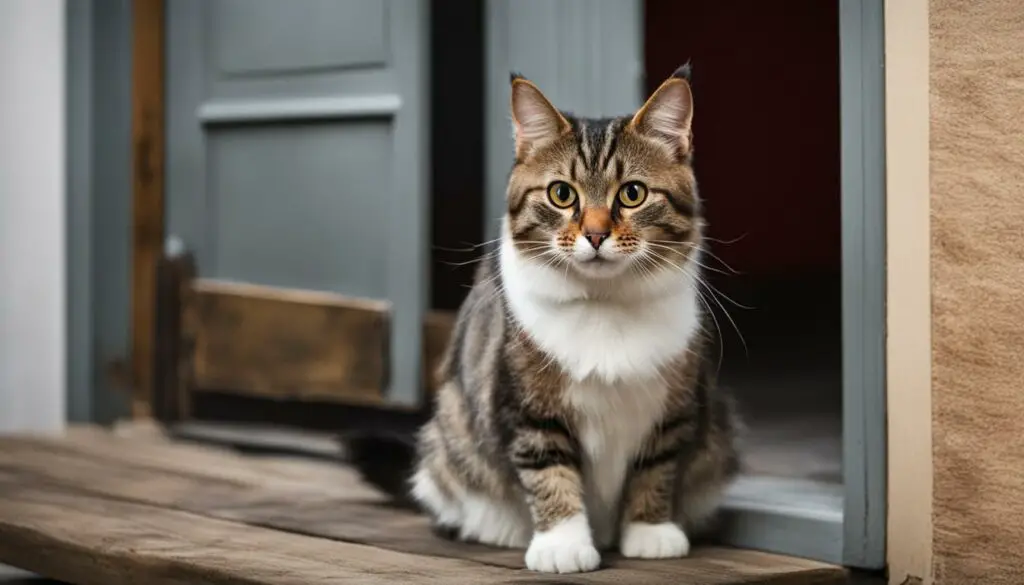
| Meow Type | Meaning |
|---|---|
| Short, high-pitched meow | Excitement or anticipation |
| Long, low-pitched meow | Frustration or dissatisfaction |
| Multiple rapid meows | Request for attention or food |
| Drawn-out meow | Loneliness or longing |
As cat owners, it’s important to familiarize ourselves with the various forms of communication that cats use. This understanding allows us to build stronger bonds with our feline companions and create a harmonious living environment where their needs are met. By interpreting their meows and body language, we can ensure that they feel understood, loved, and cared for.
Recognizing Playful Behavior in Cats
Playfulness is an inherent trait in cats, and understanding their play behavior can help foster a stronger bond between you and your feline companion. Cats express their playfulness through various actions such as pouncing, chasing, and batting objects. Recognizing these behaviors and engaging with your cat during playtime is essential for their overall well-being.
When observing your cat’s play behavior, look for signs of excitement and enthusiasm. Tail twitching, dilated pupils, and a crouched posture indicate that your cat is in a playful mood. Providing interactive toys that mimic prey, such as feather wands or laser pointers, can help satisfy their natural hunting instincts. It’s important to remember that not all play behavior is meowing followed by running away; sometimes, it’s a way for cats to initiate play with you.
To engage with your cat during playtime, use interactive toys that allow them to chase, pounce, and bat objects. You can also introduce puzzle toys or treat-dispensing devices to provide mental stimulation and reward their hunting efforts. Experiment with different types of toys to find what captures your cat’s interest the most. Remember to always supervise play sessions and ensure that the toys are safe and suitable for your cat.
| Benefits of Playtime for Cats |
|---|
| 1. Physical exercise: Playtime helps cats burn off excess energy, promoting a healthier weight and reducing the risk of obesity. |
| 2. Mental stimulation: Engaging in play enhances cognitive function and prevents boredom, keeping your cat mentally sharp. |
| 3. Stress relief: Playtime allows cats to release pent-up energy and stress, promoting a calmer and happier disposition. |
| 4. Bonding opportunity: Participating in play sessions with your cat strengthens the bond between you, building trust and enhancing your relationship. |
| 5. Behavior management: Regular play sessions can redirect your cat’s attention from destructive or unwanted behaviors, providing a positive outlet for their energy. |
Engaging with your cat through play not only provides them with physical and mental stimulation but also deepens the connection between you both. By recognizing their play behavior cues and offering interactive playtime, you can create a harmonious and fulfilling environment for your feline friend.
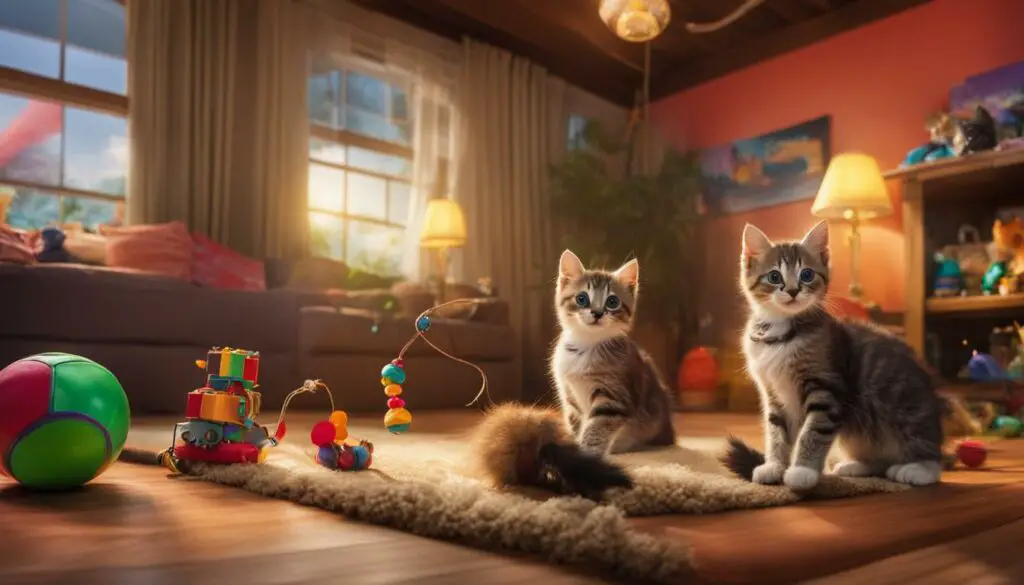
Identifying Signs of Stress in Cats
Recognizing signs of stress in cats is crucial for their well-being. While cats are generally independent and resilient animals, they can experience stress due to various factors, such as changes in their environment or routine. It is important to be able to identify these signs early on so that we can take steps to reduce their stress and create a more comfortable living environment.
Common Cat Stress Signals
Cats exhibit a range of behaviors and physical signs that indicate they may be experiencing stress. Some common cat stress signals include:
- Excessive meowing or vocalization
- Running away or hiding
- Changes in appetite or eating habits
- Increased aggression or irritability
- Excessive grooming or self-mutilation
- Urinating or defecating outside of the litter box
These behaviors may vary from cat to cat, but if you notice any of these signs, it is important to monitor your cat’s behavior closely and take action to reduce their stress.
Quote: “Cats are sensitive animals, and it is our responsibility as their caretakers to create a calming and stress-free environment for them.” – Veterinarian Dr. Emily Johnson
Reducing Cat Stress
To help reduce stress in cats, it is important to provide a safe and secure environment. Here are a few strategies to consider:
- Create a consistent routine: Cats thrive on routine. Stick to regular feeding times, play sessions, and a consistent sleeping area.
- Provide hiding spots: Cats need a place to retreat and feel safe. Offer hiding spots such as cat trees, shelves, or covered beds.
- Use calming pheromones: Products like Feliway can help create a sense of calm and reduce stress in cats.
- Engage in interactive play: Regular play sessions with interactive toys can help relieve stress and provide mental stimulation.
- Consult with a veterinarian: If you suspect your cat is experiencing chronic stress, consult with a veterinarian. They can provide guidance and recommend appropriate interventions.
By recognizing the signs of stress in cats and taking steps to reduce it, we can create a happier and healthier environment for our feline companions.
Potential Health Issues
When your cat meows and then runs away, it could be a sign of underlying health issues. Cats are masters at hiding their pain or discomfort, so it’s important to be aware of potential medical conditions that may be causing this behavior. Here are some common cat health problems to consider:
Hyperthyroidism in Cats
Hyperthyroidism is a common hormonal disorder in cats, especially in older felines. It occurs when the thyroid gland produces an excess of thyroid hormones, which can lead to weight loss, increased appetite, excessive thirst, and restlessness. Hyperthyroidism can cause cats to meow more frequently and exhibit erratic behavior, such as running away. If you suspect your cat may have hyperthyroidism, consult your veterinarian for proper diagnosis and treatment options.
Other Cat Medical Conditions
Cats can also be affected by various other medical conditions that may contribute to their meowing and running away behavior. Dental problems, such as gum disease or tooth decay, can cause discomfort and pain, leading to changes in behavior. Feline lower urinary tract disease (FLUTD) can also cause cats to meow excessively and display anxious behaviors like running away. It’s essential to have a thorough examination by a veterinarian to rule out any underlying health issues and provide appropriate medical care.
| Common Cat Health Problems | Symptoms | Treatment |
|---|---|---|
| Hyperthyroidism | Weight loss, increased appetite, excessive thirst, restlessness | Medication, radioactive iodine therapy, surgery |
| Dental problems | Bad breath, swollen gums, difficulty eating | Dental cleaning, extractions if necessary |
| Feline lower urinary tract disease | Straining to urinate, blood in urine, frequent urination | Dietary changes, medication, stress reduction |
Remember, cats are masters at hiding pain, and their meowing and running away behavior could be their way of expressing discomfort. Regular veterinary check-ups and paying attention to changes in behavior are crucial for early detection and proper management of any underlying health issues.
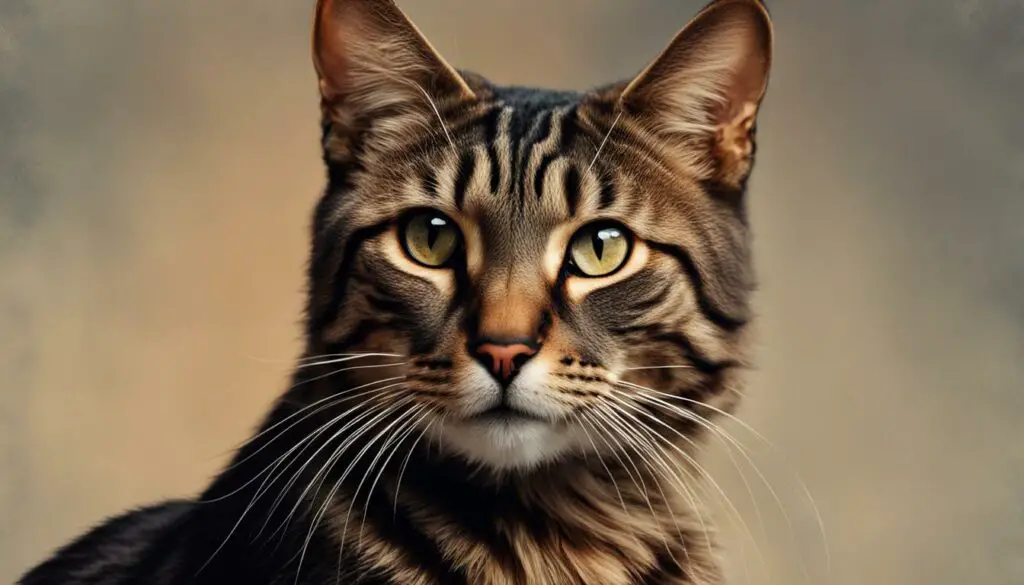
Training Tips for Behavior Improvement
Training your cat to improve their behavior can be a rewarding process that strengthens the bond between you and your furry friend. Positive reinforcement is a highly effective method for modifying unwanted behaviors and encouraging desired ones. By using rewards and praise, you can teach your cat to approach you without fear and create a trusting relationship.
One essential aspect of training is consistency. Establish a routine that includes regular playtime, feeding, and designated quiet areas for your cat to retreat to when they feel overwhelmed. Consistency helps cats feel secure and reduces the likelihood of them meowing and running away due to confusion or disorientation. A structured environment provides a sense of stability and reassurance.
When training your cat, it’s important to identify their motivations and use them to your advantage. Some cats are highly food-motivated, while others respond better to play or affection. Experiment with different rewards to find what motivates your cat the most. Treats, interactive toys, and gentle petting are all effective tools for positive reinforcement.
Remember, training takes time and patience. Break down desired behaviors into small, achievable steps and reward your cat’s progress along the way. Consistently reinforce positive behaviors while ignoring unwanted ones. With dedication and positive reinforcement, you can help your cat overcome their meowing and running away behavior, creating a happy and harmonious home for both of you.
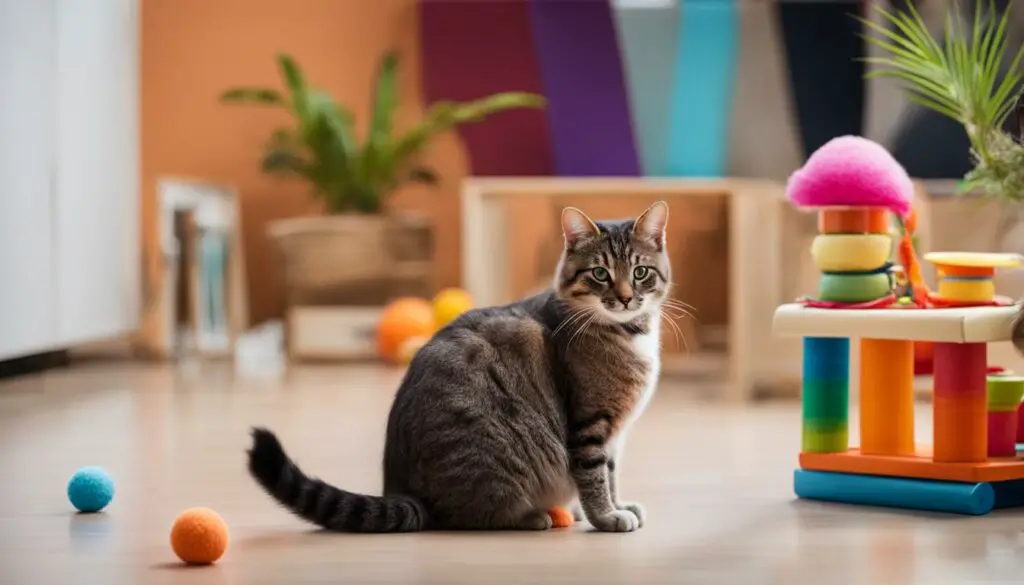
Training Tips:
- Establish a consistent routine with regular playtime and feeding schedules.
- Identify your cat’s motivations and use them as rewards for positive behavior.
- Break down desired behaviors into small, achievable steps.
- Consistently reinforce positive behaviors and ignore unwanted ones.
- Be patient and give your cat time to learn and adjust.
Conclusion
Understanding your cat’s behavior, especially when it meows and then runs away, is crucial for building a strong bond with your feline friend. By exploring feline communication, body language, and vocalization, you can gain valuable insights into why cats exhibit this behavior.
There are several common reasons why cats meow and then run away, including anxiety, fear of the dark, a preference for a specific person, confusion or disorientation, and hunger. Identifying these triggers can help you address the behavior effectively.
To address meowing and running away, positive reinforcement techniques can be highly effective. By rewarding desired behavior, creating a calm environment, engaging in interactive playtime, and providing mental and physical stimulation, you can redirect your cat’s attention and discourage the unwanted behavior.
Remember, cat communication involves more than just vocalizations. By understanding your cat’s body language and interpreting their meows, you can better meet their needs and strengthen your bond. Regular check-ups with a veterinarian are also essential to rule out any potential health issues that may be contributing to the behavior.
In conclusion, by gaining a deeper understanding of your cat’s behavior, addressing any underlying issues, and building a strong bond, you can create a harmonious living environment and enjoy a fulfilling relationship with your beloved feline companion.
FAQ
Why does my cat meow and then run away?
Cats may meow and run away for various reasons, including anxiety, fear of the dark, preference for a specific person, confusion, or hunger.
How can I alleviate anxiety and stress in my cat?
Techniques such as using pheromone sprays or diffusers, creating a calm environment, and providing interactive toys can help reduce anxiety in cats.
Why is my cat afraid of the dark?
Cats can have anxieties or fears associated with dark environments. Leaving a night light or providing a small source of dim lighting can help ease their discomfort.
Why does my cat prefer a specific person?
Cats can develop a strong attachment to a particular person, and they may exhibit clingy or needy behavior towards that individual. Building trust and strengthening bonds with other family members can help alleviate this behavior.
What causes confusion or disorientation in cats?
Cats can sometimes become confused or disoriented, which can lead to behaviors like meowing and running away. This confusion could be due to age-related cognitive decline or feeling unsure of their surroundings.
What should I do if my cat keeps meowing even after being fed?
While hunger is a common reason for meowing, it’s important to ensure that your cat is receiving enough food and scheduled meals. Meowing after being fed could indicate other underlying issues such as anxiety or discomfort.
How can I address meowing and running away behavior in my cat?
Implementing positive reinforcement techniques, such as rewarding desired behavior and providing mental and physical stimulation, can help redirect your cat’s attention and discourage unwanted behavior.
How can I understand my cat’s communication?
Cat communication involves a combination of vocalizations, body language, and scent marking. By understanding the different nuances of cat communication, such as the length and pitch of meows or the positioning of the tail and ears, we can better interpret their needs and emotions.
How can I fulfill my cat’s need for play?
Cats are naturally playful creatures, and meowing followed by running away can sometimes be an invitation to play. Understanding your cat’s body language, offering interactive toys, and engaging in playtime can fulfill their need for mental and physical stimulation.
How can I reduce stress in my cat?
Cats can experience stress due to various factors. Recognizing signs of stress, such as excessive meowing and running away, can help us create a more comfortable and stress-free environment for our feline companions.
Should I be concerned about my cat’s meowing and running away being a medical issue?
Meowing and running away could be a result of underlying medical conditions. Regular check-ups with a veterinarian and addressing any health concerns can help ensure your cat’s overall well-being and reduce unwanted behavior.
How can I train my cat to improve its behavior?
Training cats to improve behavior requires patience, consistency, and positive reinforcement. By rewarding desired behavior and ignoring unwanted behavior, you can encourage your cat to approach you without fear and build a trusting relationship.
How can I improve my relationship with my cat?
Understanding your cat’s behavior, addressing any underlying issues, and building a strong bond can help improve the relationship with your feline friend and create a harmonious living environment.

